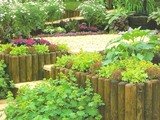|
Biointensive Gardening is a Natural and Sophisticated Way to GardenBiointensive gardening is one of the best organic gardening techniques. This particular method basically concentrates on lifting the quality of the soil thereby increasing vegetable production. And that’s exactly what we want, an abundance of vegetables straight from the garden. Let’s discuss what biointensive planting is and how to incorporate it when gardening… What’s Makes Biointensive Planting DifferentThe difference between normal garden preparations and biointensive preparation is the number of times the soil is loosened up. Now, what I mean is that when it comes to loosening up the soil, you dig deeper into the ground, at least twice as deep as normal garden preparation. This is a very good thing for the growing process of the plants. Why? ….Because the roots from the plants can travel deep into the soil in order to absorb some additional nutrients and water from the underground. Feeding the Soil with Some CompostBiointensive planting and composting is an excellent combination. It’s always good to consistently supply some nutrients to the soil. You can use stuff like straw, kitchen waste, old dry leaves or twigs, backyard scraps and add them to the soil. Combine them at a deep level into the ground and as a result you have soil with a lot more nutrients than usual. When this happens you can gain a lot of yields. Biointensive GardeningBiointensive planting is about being space efficient. That way you can use your available space to plant more. This type of gardening can allow you to combine 2 different vegetables within the same row. You can plant some of a particular vegetable and then plant a different one among those same vegetables within the same row. A good example is lettuce and peppers as their growing process wouldn’t affect each other because the pepper plants will grow taller than the lettuce. There’s no single planting involved in this type of gardening. With regards to soil preparation, no machinery is involved as it uses a lot of energy. Eliminating the use of machinery prevents soil erosion as well as the soil from becoming compact. The soil can become compact due to the heaviness from the machinery. As a result, the use of machinery can make the whole process of soil preparation worthless. Starting a Biointensive GardenThe first thing you do is to choose the crops that you want to grow. Then you design the layout and the best design to go with is a rectangular plot. The length of the plot must be in an east-west direction so that the crops can get their required amount of sunlight. Regular watering is important because of the sunlight exposure. Place compost at about 3 inches thick for the most and lay it out on top of the bed. Dig the plot twice the normal depth and transport the underground soil to the top. Open-pollinated seeds are the best for planting. You can wait until some days have passed to plant the seeds. It’s important to wait some days so that the fungus will be destroyed beneath the sun during that time. This therefore leads to the destruction of plant diseases. Water the plants if necessary at about 1 week after planting the seeds. Plants don’t really like watering during the germination process as it can affect their momentum. Remember to monitor your plants carefully to examine their behavior during the development stage and provide them with some tender care.
Develop a passion for them as they respond very well to good, special care. Biointensive gardening is a natural and go green method of gardening that can really give you a substantial yield. High quality soil and maximum production are 2 excellent benefits that biointensive gardening has to offer. These 2 benefits also make a successful edible garden.
|









